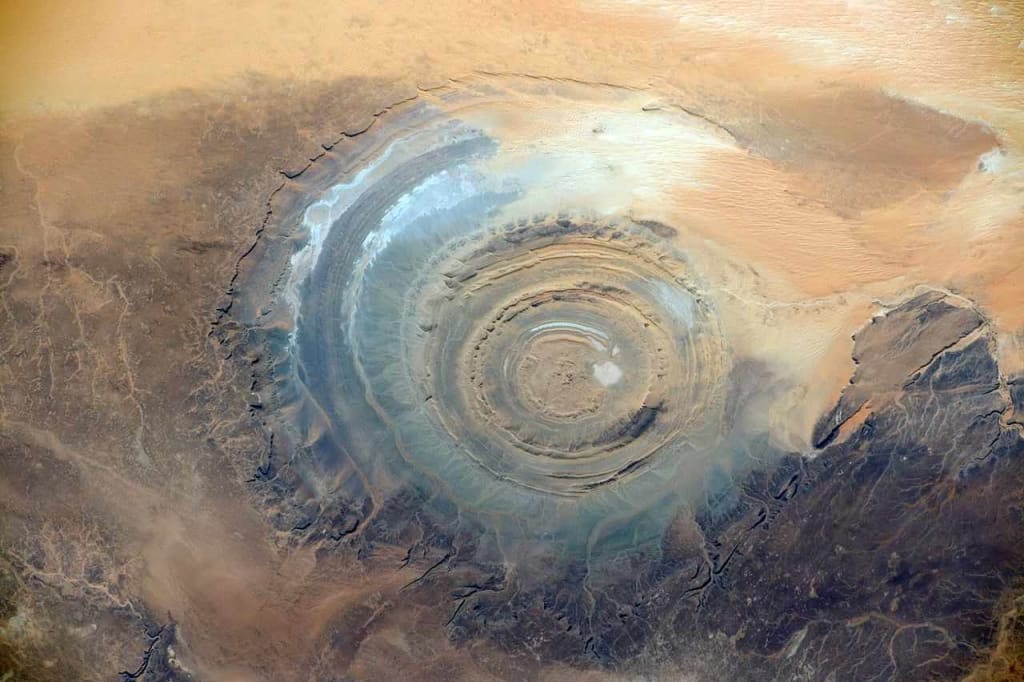WHO MADE THE STRANGE CIRCLES IN THE SAHARA
The Enigma of the Sahara: The Richat Structure WHO MADE

# The Enigma of the Sahara: The Richat Structure
The Sahara Desert, known for its vast stretches of sand and extreme aridity, holds many secrets within its bounds. Among the most intriguing is the Richat Structure, also known as the "Eye of the Sahara." Located in the west-central part of Mauritania, this geological marvel stands out due to its unique circular formation, which has puzzled scientists and fascinated observers for decades. This article delves into the history, formation, and significance of this remarkable feature, offering an in-depth exploration of one of Earth's most mysterious natural structures.
## The Discovery and Early Theories
The Richat Structure, spanning approximately 40 kilometers (25 miles) in diameter, was first identified in the 1930s by French geologist Théodore Monod during an aerial survey of the Sahara. At first glance, it was believed to be an impact crater caused by a meteorite collision. This hypothesis was primarily based on its concentric ring pattern, which is often indicative of such impacts. However, subsequent studies and the absence of shock metamorphism (a key indicator of impact events) led scientists to reconsider this theory.
By the 1950s and 1960s, the Richat Structure had become a subject of interest for astronauts and geologists alike. It served as a landmark for space missions due to its distinctive appearance, which made it easily identifiable from space. The early hypothesis of a meteorite impact gradually gave way to alternative explanations, with geological studies pointing towards a more terrestrial origin.
## Geological Formation and Structure
The current understanding of the Richat Structure's formation centers around its classification as a deeply eroded geologic dome. This dome is composed of sedimentary rock layers, including sandstone, limestone, and quartzite, which have been uplifted and exposed through millions of years of erosion. The concentric rings are the result of differential erosion, where varying resistance to weathering and erosion among the rock layers creates the distinctive circular pattern.
The central part of the structure consists of igneous rocks, such as rhyolite and gabbro, suggesting volcanic activity during its formation. Surrounding these are layers of sedimentary rocks that have been tilted and eroded to reveal the concentric circles visible today. This combination of geological processes—uplift, volcanic activity, and erosion—has shaped the Richat Structure into the form we see today.
## The Significance of the Richat Structure
### Geological Insights
The Richat Structure provides valuable insights into the geological history and processes of the region. It serves as a natural laboratory for studying the effects of erosion and the interaction between different types of rock formations. The exposure of such a wide variety of rock types within a relatively small area allows geologists to examine the relationships between sedimentary, igneous, and metamorphic rocks.
### Archaeological and Historical Context
Beyond its geological significance, the Richat Structure also holds potential archaeological importance. The Sahara Desert, though often perceived as barren and inhospitable, has been home to various human civilizations over millennia. Artifacts and remnants of ancient human activity have been discovered in and around the structure, suggesting that it may have been a notable landmark for early inhabitants of the region.
### Ecological Impact
In terms of ecology, the Richat Structure influences the local environment by affecting wind patterns and water flow. The varying elevations and rock formations create microhabitats that support diverse flora and fauna. Although the Sahara is predominantly arid, these microhabitats can provide shelter and resources for species adapted to the harsh desert conditions.
## The Richat Structure in Popular Culture and Pseudoscience
The unique appearance of the Richat Structure has captured the imagination of many beyond the scientific community. It has been featured in numerous documentaries, books, and articles, often being described as a geological wonder. Its striking resemblance to an eye has earned it the nickname "Eye of the Sahara," further fueling its mystique.
However, the Richat Structure has also become a focal point for various pseudoscientific theories and speculative claims. Some proponents of these theories suggest that the structure is evidence of ancient advanced civilizations or even extraterrestrial activity. These claims, while intriguing, lack credible scientific evidence and are generally dismissed by the scientific community.
## Modern Research and Exploration
Research on the Richat Structure continues to evolve with advancements in technology and methodology. Remote sensing, satellite imagery, and field studies have provided more detailed data on its composition and formation. Modern techniques such as radiometric dating and geochemical analysis have refined our understanding of the timeline and processes involved in its development.
One area of ongoing research is the investigation of the region's hydrology. Despite being in one of the world's driest areas, there is evidence to suggest that the region around the Richat Structure may have experienced wetter periods in the past. Studying the structure and its surroundings can offer clues about historical climate changes and water availability in the Sahara.
## The Richat Structure and Space Exploration
The Eye of the Sahara holds a special place in the history of space exploration. Its distinct appearance has made it a valuable reference point for astronauts. During the Gemini IV mission in 1965, astronauts used the structure as a landmark to track their progress over the African continent. The structure's visibility from space continues to make it a useful tool for calibrating satellite instruments and studying Earth's surface from orbit.
## Tourism and Conservation
The allure of the Richat Structure has also sparked interest in tourism. Adventurers and geotourists are drawn to the site to witness its otherworldly landscape firsthand. However, the remote location and harsh conditions of the Sahara make access challenging. Efforts to promote sustainable tourism and protect the site from potential damage are crucial to preserving its natural and cultural heritage.
## Conclusion
The Richat Structure, or the Eye of the Sahara, remains one of the most captivating geological features on Earth. Its origins, shaped by a combination of uplift, volcanic activity, and erosion, tell a complex story of the planet's geological processes. Beyond its scientific value, the structure's enigmatic beauty continues to inspire curiosity and wonder.
As research progresses and our understanding deepens, the Richat Structure stands as a testament to the dynamic and ever-changing nature of our planet. It reminds us of the mysteries that still lie hidden within the Earth's vast landscapes, waiting to be uncovered by future generations of explorers and scientists.
About the Creator
Enjoyed the story? Support the Creator.
Subscribe for free to receive all their stories in your feed.





Comments
There are no comments for this story
Be the first to respond and start the conversation.